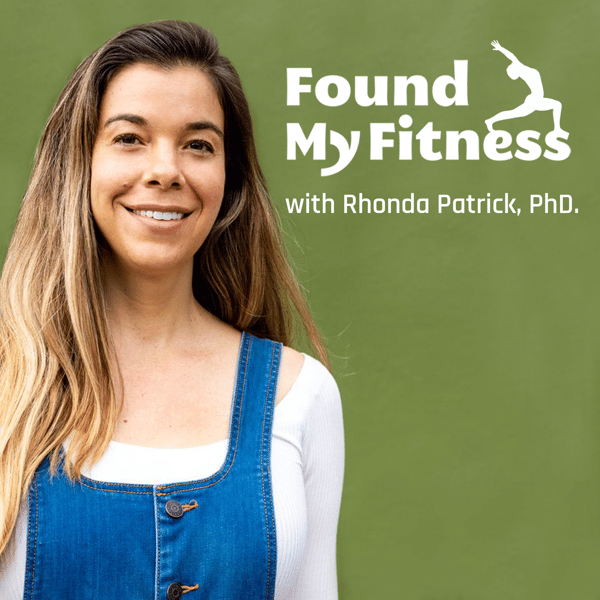#102 Why Vitamin D Deficiency Accelerates Brain Aging
FoundMyFitness
Rhonda Patrick, Ph.D.
4.8 • 5.5K Ratings
🗓️ 21 May 2025
⏱️ 17 minutes
🧾️ Download transcript
Summary
Discover my premium podcast, The Aliquot
Vitamin D is far more than just a vitamin—it's a potent steroid hormone regulating nearly 5% of our genome. Yet, remarkably, up to 70% of Americans aren't getting enough, placing them at increased risk for dementia and Alzheimer's disease. In this episode, I explore compelling new evidence from a study involving over 12,000 participants, demonstrating that vitamin D supplementation can reduce dementia risk by an impressive 40%, protecting even adults with genetic Alzheimer's risk (ApoE4 carriers).
Timestamps:
- (00:00) Can vitamin D supplements reduce dementia risk?
- (00:46) How common is vitamin D deficiency?
- (03:31) What studies reveal about genes, vitamin D, and dementia
- (05:44) Does deficiency accelerate brain aging?
- (06:45) Can vitamin D supplementation enhance cognitive function?
- (08:15) Dementia risk reduction insights from 12,388 adults
- (09:58) Why women may benefit most
- (10:49) Normal vs. impaired cognition—who benefits more from vitamin D?
- (11:21) Do ApoE4 carriers get dementia protection from vitamin D?
- (13:00) How mild cognitive impairment affects dementia risk
- (13:41) Does the form of vitamin D matter?
- (14:11) What are the optimal vitamin D blood levels?
- (15:07) What dose corrects deficiency?
- (15:33) How vitamin D directly supports brain function
Show notes are available by clicking here
The study discussed: Vitamin D supplementation and incident dementia: Effects of sex, APOE, and baseline cognitive status
Transcript
Click on a timestamp to play from that location
| 0:00.0 | Dr. Ronda Patrick here. A new study found that vitamin D supplementation was associated with a 40% lower risk of dementia over a decade. |
| 0:09.2 | After just five years, 84% of the vitamin D supplement users were dementia-free compared to 68% of the non-users. |
| 0:18.1 | This was a study of over 12,000 people. And vitamin D reduced dementia risk by |
| 0:23.2 | around 33% in adults with mild cognitive impairment and also had APOE4. This is a key genetic risk |
| 0:30.7 | factor for neurodegenerative diseases. Up to 25% of the population has one of these alleles, |
| 0:36.8 | and it can double the risk of Alzheimer's disease |
| 0:39.4 | if you have one of them. If you have two of these alleles, you can have up to a 10-fold higher risk |
| 0:45.0 | of Alzheimer's disease. Vitamin D is not just a vitamin. Vitamin D gets converted into a steroid hormone |
| 0:52.5 | that regulates over a thousand genes in our body. |
| 0:56.4 | It enters the nucleus of our cells and it regulates, it activates and turns on or it suppresses |
| 1:02.5 | and turns off up to nearly 5% of the protein encoding human genome. |
| 1:07.8 | This is very relevant because up to 70% of Americans fall into a range known as |
| 1:12.9 | deficient or insufficient. So almost 30% of Americans actually are vitamin D deficient. They have |
| 1:19.3 | levels of 25 hydrogacy vitamin D below 20 nanograms per milliliter. The other 40% or so has levels that's known as insufficient. So these are |
| 1:30.3 | people that have vitamin D levels above 20 nanograms per milliliter, but they're below 30 nanograms per |
| 1:35.4 | milliliter. And there's really a simple solution to avoiding this deficiency and insufficiency, |
| 1:40.7 | and that is a vitamin D supplement. Usually people that are vitamin D deficient, if they take around 2 to 4,000 IUs per day, |
| 1:49.8 | they can get to a sufficient level. |
| 1:52.4 | There's a lot of reasons why vitamin D deficiency and insufficiency is so widespread. |
| 1:58.4 | That is because we actually make vitamin D in our skin upon exposure from |
| 2:05.2 | UV radiation from the sun. So anything that blocks out UVB radiation is also going to |
| 2:12.4 | block out the ability to produce vitamin D3 in our skin. That includes sunscreen. It also includes skin |
... |
Please login to see the full transcript.
Disclaimer: The podcast and artwork embedded on this page are from Rhonda Patrick, Ph.D., and are the property of its owner and not affiliated with or endorsed by Tapesearch.
Generated transcripts are the property of Rhonda Patrick, Ph.D. and are distributed freely under the Fair Use doctrine. Transcripts generated by Tapesearch are not guaranteed to be accurate.
Copyright © Tapesearch 2025.

